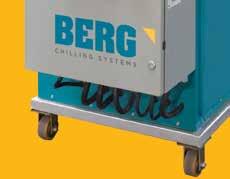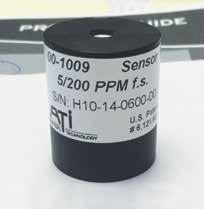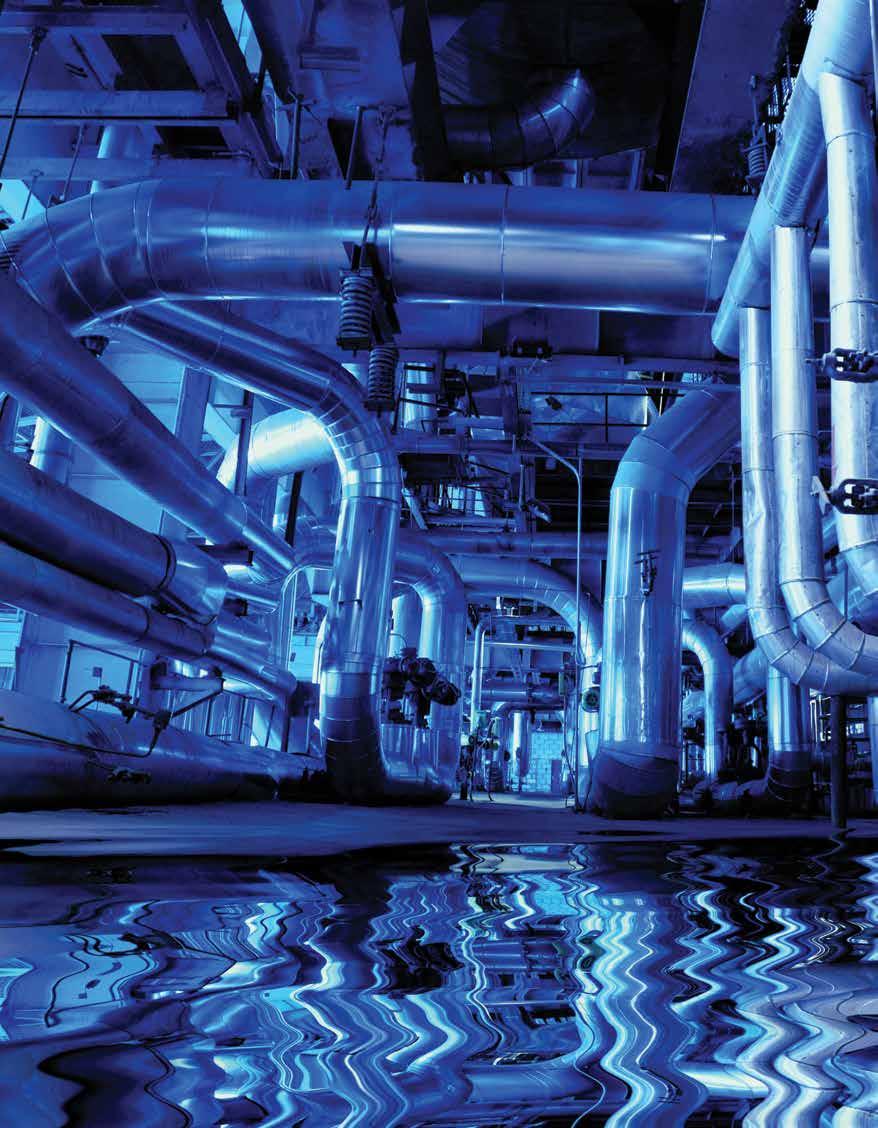
15 minute read
IIAR Membership Advances Industry with Committee Work
he past year was a productive one for IIAR’s numerous committees. From in-depth technical research to international outreach, IIAR’s membership has been busy advancing the industry. Here’s a detailed catalog of each committee’s activities, and what they hope to address in the next year and beyond. T
CO 2 : Just before the IIAR conference last year, IIAR’s CO 2 standard went up for public review. Since that time, the CO 2 Committee has updated its standard based on the comments it received. “We received approximately 140 comments,” said John Collins, chair of the CO 2 Committee. “Over the last many months, the task group who is putting together the document has gone through each and every comment, come up with a response and drafted an update to the standards document in sync with the responses received.”
While that sounds straightforward, it was anything but. “It’s quite an involved process,” Collins said. “We were meeting on a weekly basis as a task group from the time that we received the public comments in April of last year up until [late January.]”
While the comments were distributed across the entire document – 22 chapters in all, Collins said a significant amount centered on certain key sections. Many of the comments had to do with system design, piping as well as maintenance, and inspection of installed systems. Significant changes were made based on these comments.
The comments from the community demonstrates the need for such a standard. “This is an area that other standards in the industry haven’t really covered effectively, he said. “The committee and board directed us to address it in drafting this document – we need a comprehensive document, something that covers not just system design but also installation and testing. Something that covers inspection and maintenance requirements.” CO 2 differs from ammonia in many significant ways Collins said. It’s a fundamentally different chemical and as such needs to be regarded differently, specifically in the hazards it poses. It doesn’t make sense to regulate both substances in the same way. “In writing this standard, we needed to be really conscious of that,” Collins said. “We had to ask ourselves what the baseline necessity was for a safe system. Everyone has an opinion, which is fine, but the objective is to come to a baseline requirement for making these systems safe.”
As for the next steps, Collins said the committee has just completed the formal response process to all the comments. From here, the fully updated standard will be released for a second round of public review right before the 2020 Conference.
COMPLIANCE: In October, the IIAR Board voted to publish a Process Safety Management and Risk Management Plan (PSM RMP) guideline. This document will be an update to the committee’s last revision that was done about 8 years ago, Jeanna Emmons, compliance committee chair said. This updated document will reflect changes in the Environmental Protection Agency’s RMP regulations.
The committee is also working on a “how-to” document on implementing the new updates to the regulation. This will be a completely new document that IIAR members haven’t seen yet, and at the time of publication is approximately 80 percent complete, Emmons said. The how-to will present readers with best practices from industry professionals on how to best implement each section of the regulatory requirements.
Additionally, Emmons said the committee has set a goal of June to have the Ammonia Data Book fully revised and off to the IIAR Board for review and publication. This will be the document’s first update in approximately a decade. “In the last 10 years there have been a lot of changes – regulatory and application-wise – in the industry,” Emmons says. “what we’ve done is gone through each chapter and updated everything to make it current. It’s come a long way since the last publishing.”
Finally, at last year’s conference, the Compliance Committee got approval to work in conjunction with the Safety Committee to work on a guidance document on emergency planning and response. This was meant to assist dealing with the California regulatory body’s reinterpretation of several code requirements related to emergency action plans. “This document will assist the rest of the country with bridging a gap that CAL-OSHA [the California Occupational Safety and Health Administration] has found,” Emmons said.
EDUCATION:
Each year, said Mark Stencel, chair of the Education Committee, the group works to produce certificate programs, helping the Academy of Natural Refrigerants with its content and curriculum. These are open-module programs that have quizzes throughout, leading up to a final comprehensive test that determines the learner’s skills and knowledge. Passing these tests entitles the learner to a certificate demonstrating their aptitude.
“In meetings with regulatory agencies, it’s been stressed that a means to certify credentials and the gathering of demonstrated knowledge and specific expertise in refrigeration was needed. The program itself has evolved such that there are areas of specialization,” Stencel said.
Currently, the Education Committee is working on certificate programs related to IIAR 6, basic ammonia design, PSM engineering calculations, the piping handbook, mechanical integrity and the CO 2 handbook, Stencel said. These programs are designed for industry professionals to demonstrate their abilities in a formal way, and IIAR’s members have access to the programs at a discounted rate.
Additionally, through its Scholarship subcommittee, the Education Com

mittee has supported the Ammonia Refrigeration Foundation’s Founders Scholarship and this past year helped to grow the program significantly since its inception in 2016, Stencel said. In that initial year, the program received three applications. This year, it received 26.
GOVERNMENT RELATIONS: Lowell Randell, IIAR Director of Government Relations, says the first thing that comes to his mind when he thinks of industry/government relations is the world of regulations. In that regard, the Government Relations Committee has been very active over the past year.
“The committee has been working on items ranging from regulatory reform to engaging with agencies to train inspectors,” Randell said. “We’ve been providing compliance assistance materials and resources to the membership, as well.” In the area of regulatory reform, the committee is working with the National Institute of Occupational Safety and Health regarding its upcoming review of the Immediately Dangerous to Life and Health (IDLH) level that’s been assigned to anhydrous ammonia, Randall said. The committee is providing resources and information to the agency with the hope that it can demonstrate that the current level is too low, and that policy moving forward should enable facilities to use air-purifying respirators at higher levels to enhance the safety of facilities. The committee has also worked very closely with the Environmental Protection Agency to advance proposals that would correct issues with the Final Reconsideration Rule – the culmination of quite a few years of rulemaking that go back to the Obama administration’s changes to the RMP rules and added overly restrictive provisions, Randell said. The result of this effort was a revised reconsideration rule that was finalized in late 2019 that rescinded problematic regulations while preserving beneficial requirements.
The committee has also worked in the past year to build ongoing relationships with agencies. “We have a formal alliance between the Global Cold Chain Alliance, IIAR, RETA and OSHA,” Randell said. “This was renewed in August of 2019, and under this alliance we do a number of different things. The highest-profile item is training OSHA inspectors on IIAR standards and in industrial refrigeration.” This is important because many times these inspectors might enter a member facility and not be very familiar with an industrial refrigeration system. They might apply knowledge of – say – a petroleum refinery. This is not a one-toone comparison and will likely lead to inappropriate citations and other issues. “We supported the training of OSHA inspectors through a web-based program last year, and we’ll be conducting another round in February,” Randell said. “It’s been very successful – the agency is very supportive of the effort.”
MARKETING: This year, the Marketing Committee’s main focus has been on developing different types of content to inform and inspire current IIAR members, to influence the overall perception of the ammonia refrigeration industry, and to potentially recruit other industry professionals as members.
Beth Fox, Chair of the Marketing Committee, said the committee’s third annual State of the Industry report, to be available at the IIAR’s Orlando conference, addresses all those goals.
This year, the report will include more historic data so readers can better understand industry trends, Fox said. By being attentive to members’ needs, she thinks this year’s report will provide actionable information as well as educational materials with a human element to help readers connect with, contextualize and interpret the data.
A broader goal of the Marketing team, Fox said, is influencing the overall perception of the ammonia refrigeration industry. “This is actually a much broader effort,” she said. This will involve numerous different outreach efforts as well as several types of content across different types of media channels to discuss these systems and their commercial applications.
One specific part of this effort will be outreach regarding IIAR itself, directed at end uses. “Who are we? Why are we important?” Fox asked rhetorically. “Ammonia is everywhere, and people just don’t realize it.” Dovetailing from this effort will be a portal that will break down local regulatory resources by state and where end-users can interact with IIAR materials to learn more about the industry.
Finally, the Marketing Committee will continue its efforts with the internal IIAR Connect, including tech tips for members – non-commercial, pertinent information that is important for industry leaders to know and internalize.
PIPING: Gordon Struder, Chair of IIAR’s Piping Committee, said the group’s major accomplishment last year was publication of the latest edition of IIAR’s Piping Handbook. This extensive reference manual has over nine chapters related to piping in refrigeration systems breaking these systems down into each component.
“The largest update was a rewrite of Chapter One where we included two-phase flow of ammonia piping, also known as wet vertical suction risers.” Struder said. “It’s very complicated, but that was the largest addition to this particular handbook.”
The June 2019 revision was the culmination of input from committee membership – all experts on this particular topic – as well as research done by separate committees, published through ASHRE and ARF, which was integrated into the handbook.
Looking forward, the Piping Committee is hoping to take the numerous diagrams contained in the handbook and make them more detailed. Each schematic is what Struder called a “stick figure,” meaning that they are line drawings that approximate the information the diagram is trying to convey rather than being true-to-life drawings. “There’s an effort to change all of these diagrams to a 3D format which will enhance the details significantly providing readers a better depth of understanding,” adding this effort is quite an undertaking – one of the handbook’s chapters has over 40 such schematics. Struder added that there are efforts underway to translate the handbook into languages other than English, using resources from the International committee. “This will help us service a much broader base of IIAR members,” he said.
ATI has Replacement Ammonia Gas sensors for many Honeywell, Manning & Calibration Technologies models.
SENSOR OPTIONS
$195. 00

N H 3
Manning/honeywell replaceMent portable sensor
For over 15 years, ati has manufactured the ammonia sensors used in your Manning systems leak detectors. now, you can buy direct from the source and save time & money.

• Economical, Dependable, and Direct from the Manufacturer. • 18 Month “no hassle” warranty. New sensors supplied at half off if required less than 18 months from shipment. • And, we offer our own gas transmitters and alarm systems for your expansion needs.
LOCATE NH 3 LEAKS
c16 portasens ii portable ammonia Detector ATI’s C16 PortaSens II portable leak detector is used to check for gas leaks in storage areas, around process equipment and piping, and in confined spaces prior to entry.
Features
Interchangeable “Smart Sensors” for Over 30 Gases NH 3 Sensors from 0-50 to 0-2000PPM
RESEARCH: Last year, two papers were presented at the IIAR conference, one of which was used to update IIAR’s piping handbook, said Wayne Wehber, Chair of the Research Committee. The other, on ammonia dispersion in refrigerated spaces, was so popular that it will be presented again at this year’s conference.
This momentum has continued throughout the year, Wehber said. This year, a new paper will be presented at the conference that codifies guidelines for mechanical installations of refrigeration applications.
“The goal of the research committee is to have two research projects going on at all times,” Wehber said. “This keeps us busy and moving forward.” So far, one project has been approved, funded, and appointed a principal investigator: a study of machinery room ventilation and ammonia release computational fluid dynamics.
This is related to the previous study of refrigerated spaces, but the project specifically looks at machinery rooms. A primary focus of this research, Wehber said, is to look at the ventilation rate requirements in IIAR 2. In addition to using modeling to determine what the minimum ventilation rates should be, the project will be determining the best placement of ammonia leak detectors in these particular spaces.
The second project, an IIAR relief valve and pipe sizing program, will research the proper sizing of relief valve piping. This project is in the works – the Committee is currently in the process of writing the work statement, Wehber said. “[These projects] are filling the pipeline,” Wehber said. “We try to keep projects going while others phase out, so we have a few additional projects that are in queue. We’re putting the information together and prioritizing the new research projects. Hopefully, we’ll keep project ideas coming from the committees, from the IIAR community and from the industry.”
SAFETY: This past year, the Safety Committee’s biggest project had to do with manual hand-valve lock-out/tag-out issues. Joe Fazzari, the committee’s chair, said that IIAR wants to publish an informational guideline document that addresses how manual valves are treated in the industry. This is necessary, Fazzari said, because current guidance from the Occupational Safety and Health Administrations unclear when it comes to ammonia refrigeration industry applications. OSHA approached IIAR to ask for the organization’s input.
“It’s a little bit gray when it comes to our industry… Is it a lock-out/tagout program or is it an energy-control program?” he asked. “How can we give IIAR members the best information on how to handle this issue? This is us responding back to OSHA and to our members and applying the experience and expertise of our volunteer members and affiliate associations.”
This project was the priority of the Safety Committee in the past year. “There was lots of discussion,” Fazzari said. “We did a couple of surveys, and we’re getting close to publishing the analysis of the results.”
The responses to the surveys, Fazzari said, were significantly varied, indicating a need for IIAR’s standardization. He said he believes the published analysis will do exactly that. As far as timelines go, Fazzari expects it to be completed within the coming year. “We’re going out to bid right now for contractors to help us write the document… I’d say it [will be ready] within the next year or less.” Also worth noting, Fazzari said, will be a workshop during the conference’s closing session on this topic. IIAR members are encouraged to attend to learn more and to share their experiences.
STANDARDS The Standards Committee will soon release an update to IIAR 2 for its first public review, Eric Smith, vice president and technical director at IIAR, said. This review covers the five-year periodic maintenance practices and piggybacks off of last year’s addendum A revisions. “[We] have collected comments and feedback from IIAR 2-2014 over the past several years, and we have been discussing those comments and changing the standard as necessary to address them,” Smith said. “Further, this edition will address a number of ambiguities stemming from the last publication and further refine the standard.”
Smith pointed out that this revision is a major one with over 200 items analyzed for the update. He said several significant changes have been made to the standard including ammonia detection reliability requirements, to name one. “It’s something people should tune into.”
Work has also begun on revisions to IIAR 4, IIAR 5 has recently been updated and re-published and the long-awaited IIAR 6 – the standard on inspection, testing and maintenance – was published last summer,
Looking farther ahead, the Standards Committee is anticipating completion of IIAR 2’s five-year review process. Smith said once this process is concluded, there’s a possibility the International Fire Code will adopt the standard in its entirety rather than writing their own codes for ammonia refrigeration. The committee is also looking into the possibility of drafting a hydrocarbon standard in the near future which would apply to non-listed systems.
Additionally, much of the work of the Codes Committee has been absorbed by Standards this year. Of this work, Jeff Shapiro, IIAR’s code consultant, said the International Mechanical Code, the Uniform Mechanical Code, the NFPA 1 Fire Code and ASHRAE 15 no longer specifically regulate ammonia refrigeration and are instead deferring to IIAR standards, and particularly IIAR-2. “Our next advocacy effort in the model codes will be attempting to get the International Fire Code to defer to IIAR 2, like [the codes listed above], Shapiro said. “That effort will be developed in 2020 and advocated in the 2021 code cycle. If successful, the changes would appear in the next edition of the IFC in 2024.”
The quality and superiority of IIAR’s consensus documents is the organization’s “calling card” to encourage international adoptions of IIAR standards. Shapiro added. The consensus process contributes a lot more brain power to IIAR documents than can be achieved by government-run processes.











